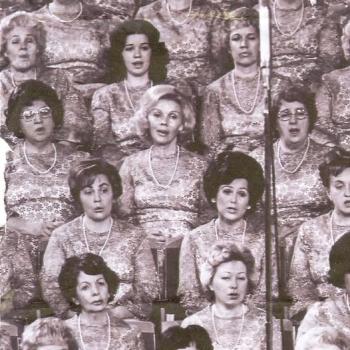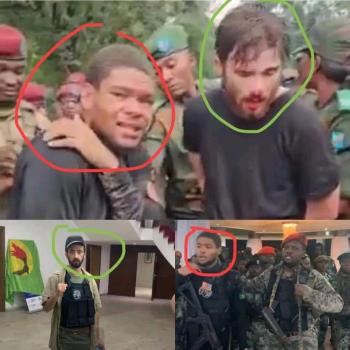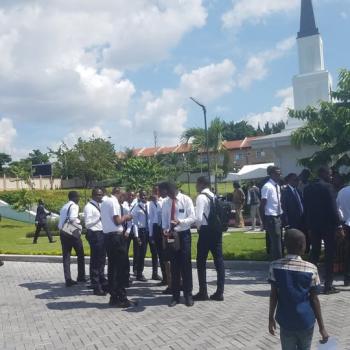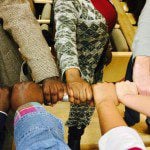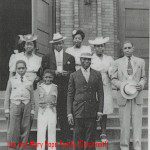 I left Utah on Thursday, July 2nd at 3:15 p.m. and flew to Denver, planning to board a connecting flight to Columbus, Indiana, where I was needed by my nieces. I found the right gate quickly. It said Columbus. I sat down and worked on my screenplay about Len and Mary Hope, a Black couple who attended an LDS Church in Cincinnati, Ohio (1936-ish) until the branch presidency let them know that they should no longer come to church.
I left Utah on Thursday, July 2nd at 3:15 p.m. and flew to Denver, planning to board a connecting flight to Columbus, Indiana, where I was needed by my nieces. I found the right gate quickly. It said Columbus. I sat down and worked on my screenplay about Len and Mary Hope, a Black couple who attended an LDS Church in Cincinnati, Ohio (1936-ish) until the branch presidency let them know that they should no longer come to church.At the time, the LDS Church maintained a “priesthood restriction” which did not allow Blacks to participate in the most important rituals of the Church. The restriction was supported by common folklore that Blacks were descendants of Cain or that God was discriminating against them because of something they had done or not done in a pre-mortal world. The restriction was reversed without commentary in 1978. The undergirding ideas behind the restriction were “disavowed” in 2013. Not surprisingly, they still resurface. There are still many (particularly in the older generation) convinced that the priesthood restriction was God’s idea and we simply don’t know why He decided to exclude his Black children from full church participation.
Darius Gray and I wrote about Len and Mary Hope in our book, The Last Mile of the Way .
In mid-June, 2021, I had a sense that we needed to return to Len’s story. We knew about the chapel in Cincinnati where Len and his family tried to worship before they were excluded. We had interviewed Marion D. Hanks multiple times about his efforts as a young missionary to transform the synagogue which the LDS Church had purchased into a suitable chapel, and then about his ministry to the Hopes, and their ministry to him.
As I began my trip on Thursday, July 1, my husband was aware that I would be working on the screenplay during my flights. My co-author, Darius Gray, was also aware of the project, as was Marion D. Hanks’s son, Rich, and Elder Jeffrey Holland, whom Bruce and I had talked to the Thursday before my trip.
I was heading to Columbus to be with my brother’s daughters. My brother and sister-in-law were in England, and there were circumstances which invited my presence at their Ohio home.
As I was talking to my brother (in England), I mentioned that the sign at my gate had changed. It no longer said Columbus but Charlotte. The person next to me said, “Are you going to Columbus? The gate changed. It’s A-40.” I got off the phone and dashed to the new gate. There was the plane. But the door was closed. I asked the women at the counter if I could board. One of them said, “We’re flight attendants. There’s nothing we can do.” The plane began its slow taxi towards the runway and I made my way to a long line of dissatisfied Frontier customers. Two hours later, I was at the counter. I asked when the next flight to Columbus was. “Sunday,” the attendant said.
Sunday was my return day.
I then had a series of little brain flickers. How about Indianapolis? I could get there and then drive to Columbus. How about Cincinnati?
I could get to Cincinnati if I flew to Orlando at midnight and transferred to another plane. I would arrive in Cincinnati around noon.
I put a notice on Faceboook:
“If you are in Cincinnati, give me some ideas on the best way to get to Columbus. Seriously. I need a ride or a bus route or train route. “
I then sent this email to Jana Riess:
“Hi Jana! Are you still in Cincinnati? I will be there (completely unexpected) tomorrow. I would love to see you. My flight arrives around noon. I won’t be there for long.”
Jana wrote back:
“That’s wonderful! Yes, I’d love to see you too. I have no scheduled plans this afternoon other than work, which is flexible. Let me know what you want to do/see.”
She offered to pick me up at the airport, and I gratefully accepted.
Meanwhile, I was in communication with people who had participated in the luncheons at the Hopes’ place. They thought that the church no longer existed. I accessed the internet while waiting for the flight to Orlando and saw that the church did indeed exist. It had been purchased in 1954 by a Maronite (Lebanese Catholic) congregation.
The church was near Jana’s house, though she didn’t know the history and hadn’t been there.
We rang the bell. Nobody came for a minute, and then a youngish (thirty-something) man answered the door. He asked if we wanted to worship. We told him that we were Latter-day Saints and knew that the building had once belonged to the Mormons. We simply wanted to see it.
“You’re Latter-day Saints?”
“Yes.”
“We know that your church was here, but I don’t know the story. I have wanted to learn the story.”
I told him that I knew the story and had written about it. I could send it to him as soon as I got on my computer.
He said that they were in process of remodeling the church, so we couldn’t go into the sanctuary, then added, “There are films. Photos. As we were excavating, we found these films from when the Mormons were here. Someone went through the whole building and filmed it. It was on—the round kind of–. He gestured.
“Film,” I said. I am old enough to remember those metal canisters.
He opened his phone to show me the things he had digitized from the trove of archival material. “I’m an archaeologist by trade, so these findings have been fascinating to me,” he said. “I am grateful to your church for what it has done with genealogy. I know that you gather names to do baptisms, but the names themselves and the histories are the treasure for us.”
I replied that the story of each person is sacred scripture.
He had wanted to invite the Latter-day Saints to their re-dedication reception on August 17th, 2021, but didn’t know who to call. I told him I would connect him to church leaders in Salt Lake City and in Cincinnati. More importantly, Jana let him know that she lived in Cincinnati and that she would attend. (Jana is an important writer for Religion News and does columns which my daughter and I read whenever they’re published. Her words have often been an inspiration for me.)
We took some literature about his congregation—the Maronites—and took his card, which I photographed and texted to Darius. When I was finally able to talk to him, I said, “There’s film.” I described what the priest had told us about.
Darius got into contact with the Church History Department immediately after we hung up.
A few hours later, I got this message from Father George Hajj—the priest we had met:
“Welcome, dear Margaret,
It is a blessing that you and Jana visited us today!
We look forward to working with you on the meaningful project you are doing.
God willing, the rededication ceremony is on Tuesday, August 17. The Divine Liturgy is at 6:00 pm, followed by a dinner in the large hall.
I look forward to staying in contact.
May God bless you.
Fr. George Hajj”
I responded:
“It was miraculous that we met. I was not supposed to be in Cincinnati today. I missed my flight to Columbus and was rerouted to Orlando and Cincinnati.
I have already made connections for you. God clearly cares about what you’re doing.
We will certainly stay in touch.”
I believe that a great shift is happening in the USA as we confront the primal sin of this nation—slavery—and the systemic racism which is a consequence. I won’t waste time debating whether or not it exists. I have seen its effects and write with full conviction that it is pervasive.
I also believe that a great shift is happening in the Church of Jesus Christ of Latter-day Saints. I would call it repentance, metanoia, evolution. The Len and Mary Hope story is a part of that shift. Darius and I learned last week that the church history books called _Saints_ will be featuring the story of Len and Mary in the near future. How interesting.
Latter-day Saints have been urged to “lead out in abandoning attitudes and actions of prejudice,” but we are in an interesting time when the rhetoric of Black Lives Matter and Critical Race Theory and reactions to both have become triggers for non-productive argument rather than action. Racism has revealed itself anew among members of our church. Because of our overt racism from 1852-1978 (the restriction plus appalling teachings which accompanied it), I believe that we as a church are uniquely positioned to address racism with abject humility and effectiveness, modeling how to heal a wound, to correct a wrong.
Jana and I continued working on the Hopes’ records until she took me on a little tour of Cincinnati and then to the bus stop. Her subscription to a newspaper archives app was instantly fruitful. Through archived newspapers, we learned that Len and Mary Hope lived in an area called Franklin Heights, which was a successful black community. We learned that Len’s son, Len Jr. (AKA Lynn Hope) formed the Lynn Hope Orchestra with other family members and played jazz throughout the northeast. I even found some of Len/Lynn’s music.
We realized that we had uncovered a fascinating piece of history. The Hopes had hosted dinners at their Franklin Heights home for the missionaries, who would give them communion (the sacrament) . But it didn’t stop with the missionaries. So many people started attending that the Hopes had to limit their offerings to dessert, not a full dinner. We now have evidence that many Mormons went into a Black neighborhood to be with Len and Mary Hope and their children, because the Hopes had been excluded from the church in a white neighborhood. It is a remarkable thing.
There has been some debate about how the Hopes’ exclusion came about or if it was even ever verbally stated. We know something of that because of a personal interaction. When Darius and I were working on our books, he met a man while picking up a prescription.
“You’re Darius Gray,” the man said.
“I am! And who are you?”
The man looked down. “I don’t know if you’ll want to know who I am once I tell you. I was in that meeting where it was decided that Len and Mary Hope couldn’t come to the church in Cincinnati.” Somewhere, Darius has that man’s name on a piece of paper. He is looking for it now.
As for me, I wrote these words to my daughter last night:
“It has been a day of exhausting miracles and I don’t want any more miracles right now.”
But if I need to pay attention to something at the airport where I am sitting right now, I certainly will. There is a heavenly work happening all around us, seeking to urge us to unity and love. Miracles will not wait until a more convenient time.



